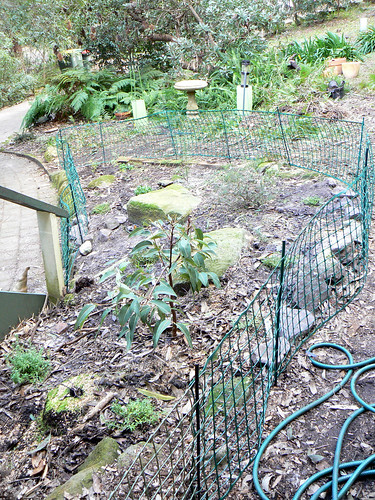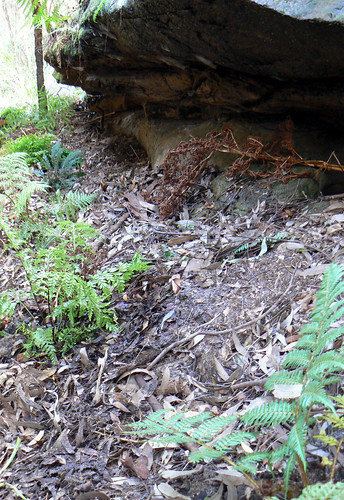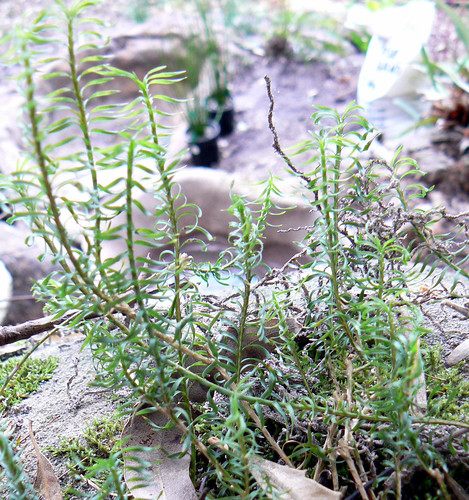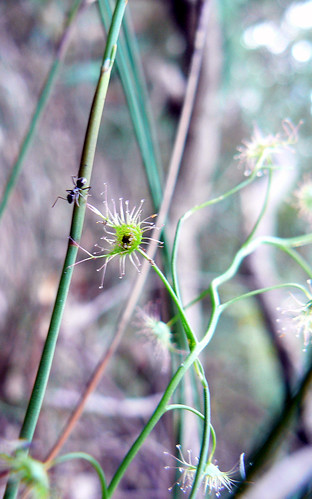As a result, I've had to take firm action, fencing off some garden beds and putting protection around some young shrubs and saplings. Not pretty, but I hope it'll help deter the mammals. (Why don't they kill the bloody agapanthus, I ask myself.)
The fenced-off beds have a few additions, mainly ground-covers:
Rhodanthe anthemoides
Dampiera diversifolia
Scaevola humilis
Dryandra nivea
Hibbertia vestita (My spell check just suggested that should be "libertine transvestite", by the way. Novel.)
Chrysocephalum apiculatum
Crowea exalta
Chorizema cordatum x varium

You can see the poor old Corymbia in the foreground, with all its soft new growth chewed off. I don't think there'll be flowers this year.
Elsewhere in the garden I've planted:
Melaleuca bracteata
Eucalyptus cladocalyx
Cassinia denticulatum
Podocarpus spinulosa
Acacia floribunda
Stenocarpus sinuata
Syzygium australe
Some of these will grow to very large trees, and no, they're not near the house!
I've removed the rampant fish-bone fern from the fernery by the side of the house and put in a few other indigenous ferns:
Asplenium bulbifera (Hen and Chicken Fern)
Adiantum aethiopicum (Common Maidenhair) (Or, as the spell check would have it, "Quantum Ethiopian".)
Doodia aspera (Prickly Rasp Fern)
Cyathea australis (Tree Fern)

Erosion is a bit of an issue around the pond at this point, so I hope some of the plants I've put on the pond banks will help with that.

Asplenium australasicum (Birds Nest Fern)
Myoporum parvifolium
Viola hederacea (Ivy-Leafed Violet--almost a weed around here, but it's great for stabilising soil)
Lomandra confertifolia
Doodia aspera
Doryanthes excelsa
Baloskion tetraphyllum subsp. tetraphyllum (still in pots)
Gleichenia dicarpa
The latter, also known as Pouched Coral Fern and Tangle Fern, grows in a lot of the garden and in the adjacent park. It's so pretty and delicate, I really want to encourage it.

This is Lomandra obliqua, which is growing over the rocks above the ponds.

Finally, I came upon this, growing on the sandstone shelf above the fernery. I don't know what it is, but it certainly seems to be insectivorous. I'll send photos off to the Herbarium next week to get an ID, but in the meantime if anyone knows, please, post!

Who am I?
The carnivorous plant you've found appears to be Drosera peltata. At least that's my best guess. Great find! I've got a few Drosera species in one of my potted bog gardens on the porch. Cheers!
ReplyDeleteThanks, Ryan. I was thinking it was probably Drosera, but didn't know which species. I've heard back from the ID counter at the Herbarium of NSW, and they agree on the genus, but want to see photos of the leaves (which I presume should be in basal rosettes?) and have an indication of leaf size to be more precise.
ReplyDeleteIt's raining again today, so I won't get a chance to take more photos for a day or two.
Just looked at your link, and it seems to be the one. Nice thing to find in the garden. :) Much appreciate--thanks again!
No problem! Most Australian Drosera species are tuberous, and those usually take the form of a basal rosette of leaves, indeed. D. peltata is one of the ones that has the form shown in your picture, though they can also form basal rosettes. The leaf form looks right, though--cauline.
ReplyDeleteIncidentally, if you can manage it and if you think of it later, could you send some of that rain my way? I just moved from the west coast to the midwest US and we're in serious need of precipitation. I'd appreciate it! :-)
Ryan, here's the entry in PlantNet (run by the National Herbarium of NSW) on Drosera peltata, FYI.
ReplyDeleteI'd love to send you some rain, but I think I might get into trouble from my fellow Sydney-siders. Although we've had lots of rain lately, we're still officially in drought, still on water restrictions, and just over the other side of the mountains, our farmers are still in dire straits. Don't they have lots of water up on the US north west coast? Maybe they can spare you some. :)
They usually have lots of rain in the winter, but in the summer they barely get a drop. When I lived there, I couldn't believe how beautiful the summers were! (The locals began to complain that it's too hot if the temperature got anywhere above 24°C. I'm used to 35° heat in the summers, so it was no problem for me!)
ReplyDeleteNo water restrictions here yet. And we've got to keep my partner's garden's green! Though I'm going to try to convince him to use native plants instead of those rows of water-guzzling Impatiens walleriana that he has out there now. Hehe.
Yeah, impatiens are such thirsty beasts. Of course, in my garden they're simply considered weeds! You definitely must wean your partner off them. :)
ReplyDeleteYour question about why the mammals don't kill the agapanthus reminded me of a similar question I have often asked myself...why don't the snails keep the grass short?
ReplyDeleteHmm, at a rough guess, I'd say it's down to the Universal Law of Snail Herbivory. Only eat what the humans don't want you to eat. :)
ReplyDeleteAre you the Deb from Richard Wiseman's blog? If so, welcome! (And if you're not, welcome anyway!)